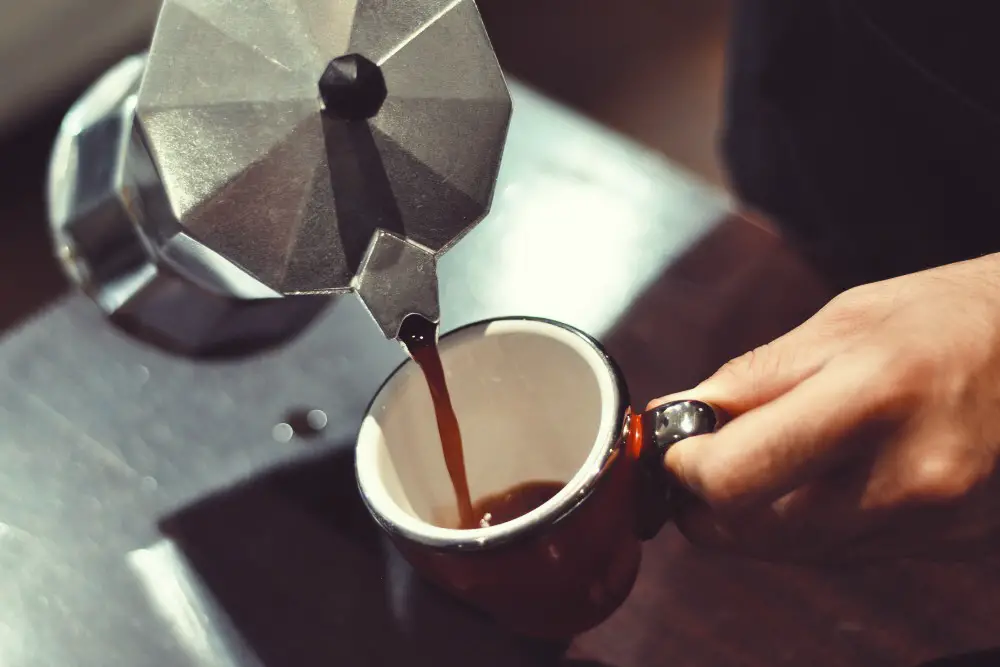Table of Contents
*This post may contain affiliate links. As an Amazon Associate we earn from qualifying purchases.
The moka pot is one of the most iconic appliances ever made. It has been a staple in many households for decades due to its affordable price, ease of use and its ability to produce commercial espresso-like coffee to the average home.
Talk to an Italian grandmother and she’ll tell you straight away that the best espresso is made on the stove top with a moka pot. It has been keeping old-school coffee lovers happy since the 1930s They can produce stronger, thicker coffee with a solid crema. But in the era of pods, the iconic coffee pots have become an endangered species.
If you want to step up your espresso game without investing in an expensive machine, this blog post is for you. This moka pot brewing guide is aimed at empowering coffee lovers out there to brew the best moka pot coffee you possibly can.

Image Source: https://whitehorsecoffee.com
Grind the coffee beans
Grind your coffee beans to a fine consistency. It’s a little finer than table salt. Pre-ground coffee you usually see in grocery stores are usually fine grind. Make sure you have enough coffee to fill the filter basket.
Consistency is the key to brewing a great cup of coffee. Opt for a burr grinder over a blade grinder.
Pre-heat water
Heat the water and turn off the heat just before the water boils. We do this to keep the temperature of the moka pot from getting too hot and scalding the coffee grounds, which can give the coffee a metallic taste. It also allows the extraction to take place more quickly.
Fill pot with water
Fill the bottom chamber with hot water. Most pots are marked with a line to show the fill level. If you don’t find any, then go ahead and fill it up to the relief valve on the side. Make sure you don’t add too much water. Overfilling will water log the coffee and affect the flavor.
Fill the filler basket with ground coffee
Insert the funnel and fill it with ground coffee. Do not stamp or overfill it with coffee. It will be difficult for the water to travel through if the coffee is too tightly packed. Just give it a gentle tap or shake to help the grounds settle evenly.
Re-assemble the unit
Place the basket, filled and flattened, into the lower pot. Then, screw the top onto the boiler base. Use a cloth or gloves if it is too hot. Screw it on pretty tight so it stays on well and won’t leak, but don’t over tighten.
Place the pot on stove
When heating the moka pot on the stove, you want the flames to be small, fitting underneath the base of the pot. Make sure that the flame isn’t hugging or surrounding the base of the pot.
If you can, place the pot closer to the outer rings of the stovetop to prevent the handle from getting too hot. Leave the top lid open.
Leave it for about 5 to 10 minutes, depending on the size of the moka pot. You’ll want to heat it slowly to extract the full flavor of the espresso.
Pay attention to the coffee level
After a while, coffee will start oozing into the upper chamber. If you did it correctly, you will notice thick, golden-brown syrup coming out in a slow trickle. It will become thinner and lighter as the extraction continues.
When the coffee is about 80% of the way up to the spout and foam starts to appear out of the spout, it means that your brew is done. Remove the pot from the stove and place it on a cold towel.
The cold towel keeps the pot from scalding the liquid coffee, which reduces the risk of bitter coffee. It also cuts off the brewing, so over-extracted coffee doesn’t keep rising.
Serve and enjoy
Two cups of amazing coffee in ten easy steps. Pour it into cups or a carafe. Serve and enjoy.
Clean after brewing
Moka pots will last a decade when cleaned and taken care of properly. Make sure that you clean your moka pot after brewing. Otherwise, it will ruin the taste of your future cups of coffee.
Coffee has a lot of oils and flavors. We want to get rid of the already-extracted ground while still preserving whatever oils are leftover to enhance our next cup a little bit. That said, we advise that you wash your moka pot only with warm or hot water.
Rinse the coffee maker with hot water and let dry thoroughly before screwing the chambers back together.
Final thoughts
As compared to other brewing method, moka pot requires more trial and error and skill to achieve the perfect brew. But once you master it, you’ll be able to produce beautifully bittersweet, extremely concentrated cup of percolated coffee.
Follow this brewing guide and you’ll be able to make great espresso using a stovetop coffee maker at a fraction of the price.

